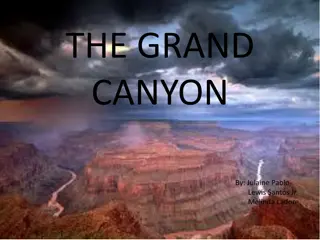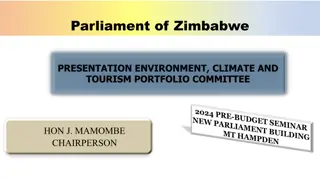Exploring the Grand Canyon: History, Climate, and Location
Uncover the fascinating geological history of the Grand Canyon, from its formation through erosion to its early inhabitants. Learn about the diverse weather and climate patterns, ranging from summer thunderstorms to winter snowfall. Discover key facts about this natural wonder in Arizona, including its vast size, unique wildlife, and impressive dimensions.
Download Presentation

Please find below an Image/Link to download the presentation.
The content on the website is provided AS IS for your information and personal use only. It may not be sold, licensed, or shared on other websites without obtaining consent from the author. Download presentation by click this link. If you encounter any issues during the download, it is possible that the publisher has removed the file from their server.
E N D
Presentation Transcript
THE GRAND CANYON By: Julaine Pablo Lewis Santos Jr. Melinda Ladore
Introduction The History The Weather and Climate The Location and some facts
HISTORY Was formed through erosion The layers of the Grand Canyon are a spectacular feature that reveals various time periods and conditions. Ex: how it was formed..( the layers are steep) Sediments left behind reflect the conditions (muddy, rocky, sandy, volcanic, etc.) of certain time periods. The people of the Grand Canyon were Native Americans for thousands of years. More recently, hunter-gathers lived in the area until about 1000 BC. Archeological findings, such as pottery found in the canyon, have been carbon dated to 4000 years ago.
The Weather and the Climate Elevation and season typically dictates average temperatures at the Grand Canyon. Elevation at the top of the South Rim average about 7000 feet with the North Rim averaging 8000 feet. As you descent into the Canyon, the elevation drops gradually to about 1500 to 2000 feet on the canyon floor. The higher the elevation, the cooler the temperature. Summer thunderstorms frequently occur during July, August, and early September with the potential for torrential rains, frequent lightning , and sudden flash floods. They occur mainly between the hours of 11am and 6pm. Summer heat give way to cooler temperature during the fall months of September and October with progressively cooler temperatures in the latter fall periods. Winter weather conditions on the South Rim can be harsh but the North Rim can be worse. Starts in the mid-October and ends in mid- May. By mid-April, winter weather usually begins to break, and warm spells become more frequent.
The Location and some facts Is located in Arizona One of the great natural wonders of the world. Averages 5 million visitors per year. Spans 1,217,403.32 acres or 1,904 square miles. Is 277 river miles long. Measures minimum width of 600 feet (Marble Canyon); average width, rim to rim, 10 miles; maximum width, rim to rim, 18 miles. Drops almost one mile at deepest point. Rim elevations: South Rim 7,000 feet; North Rim 8,000 feet; Lake Mead Boundary 1,200 feet. Is home to 75 species of mammals, 50 species of reptiles and amphibians, 25 species of fish and more than 300 species of birds. Boasts approximately 2,500 species of plants, mosses and other vegetation. Averages temperatures of 18-85 degrees Fahrenheit, South Rim; 15-77 degrees, North Rim; 38-105 degrees, Phantom Ranch.
















































